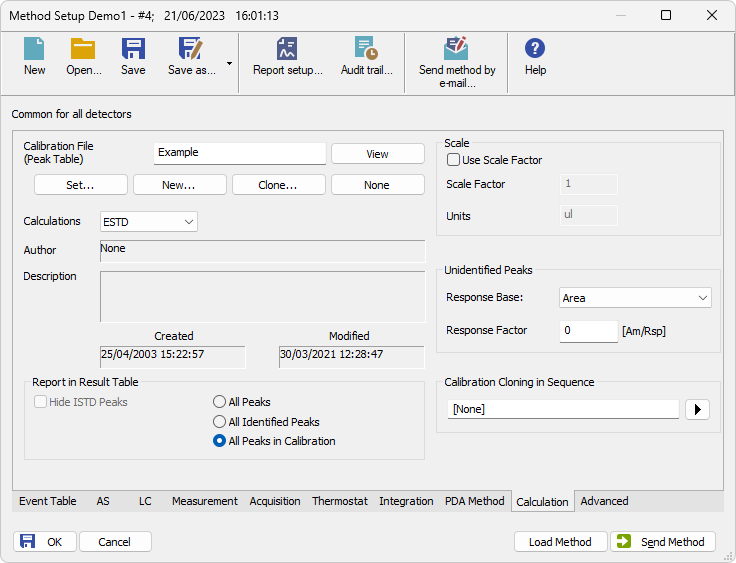Calculation
Sets the calculation parameters of the method. It links the method to a calibration file, specifies the calculation type, and includes additional settings such as units, response factor for unidentified peaks, and result display options.
When invoked by the menu command or via the  icon, the Method Setup dialog on the Calculation tab will open. When utilizing a multi-detector chromatogram, the tab is common for all signals.
icon, the Method Setup dialog on the Calculation tab will open. When utilizing a multi-detector chromatogram, the tab is common for all signals.

Method Setup - Calculation
Specifies the calibration file to be used when evaluating chromatograms measured with this method. Chromatograms will be automatically calibrated using the selected file.
Note:
If the calibration file or method is located outside the default project structure, Clarity stores the file path as absolute. When such files are moved or copied, the path may no longer be valid and must be manually updated.
The section includes the following buttons:
Opens the calibration file in the Calibration window. As the Method Setup is a modal window, the Calibration window opens beneath it. To access it fully, you need to close the Method Setup dialog first.
Assigns an existing calibration file to the method.
Creates a new empty calibration file and opens the Save As dialog to specify its name and location.
Creates a copy of the current calibration file using the Save As dialog. The cloned file is then linked to the method. If you want to keep only Compound Names and Retention Times (without Responses), check the Clear Responses option in the Save As dialog.
None
Removes the calibration file from the method and switches the calculation type to Uncal (uncalibrated).
Selects the calculation type:
Uncalibrated chromatogram, no calibration file is used. The result is a percentage share of the individual peaks in the chromatogram.
External standard method. The result (in the Amount column) is calculated using the calibration equation of the particular compound from the Response value of that compound.
Internal standard. The result (in the Amount column) is calculated using the calibration equation of the particular compound from the Response value of that compound, adjusted by the ratio of responses of the internal standard in the unknown sample and in the standard.
With this calculation mode, the calculations are performed identically to the ESTD calculation mode according to the actual calibration settings with an added validity check: it is verified that all integrated peaks in the chromatogram are calibrated or have Amounts calculated in other way, and the Sample Amount is not filled in. If these criteria are not fulfilled, no results are calculated, a warning message appears in the Result Table header, the Peak Type is set to Error, and the Amount% is empty.
Standard addition calculation. It calculates compound amounts in the unknown sample by extrapolating the calibration curve to the point where Y = 0. Results are displayed as absolute values.
To use standard addition correctly, first set the name of the cloned calibration file in the Calibration Cloning in Sequence section. Then, in the Sequence Options, in Calibration and Sequence Usage section select the Standard Addition Measurement option.
Details of Calibration file
Name of the user who created the calibration.
Informative description of the calibration.
Date of the calibration file creation. When copying or moving a calibration file, the Created field contains the date of this copy or move operation.
Date of the last modification.
Specifies which peaks should be displayed in the Result Table when a calibration is used. If the Calculations setting is set to Uncal, this section will be inactive (grayed out).
Hides peaks identified as internal standards from the Result Table.
Displays all integrated peaks found in the chromatogram.
Displays only the peaks that were identified based on the calibration file.
Displays all peaks from the calibration file, regardless of which peaks are found in the chromatogram. This creates a fixed table format based on the number of calibrated compounds.
Provides parameters for scaling calculated results. If the Calculations setting is set to Uncal, this section will be inactive (grayed out).
Enables the use of the Scale Factor and Units fields.
Multiplies all values in the Amount column in the Result Table by the specified factor.
Replaces the original amount units from the calibration file with the defined units in the Result Table.
Defines how to treat unidentified peaks. If the Calculations setting is set to Uncal, this section will be inactive (grayed out).
Selects whether to use Area or Height as the base for response.
Multiplies the selected response base to estimate the Amount of unidentified peaks. This effectively acts as a single-point calibration.
Calibration Cloning in Sequence
Sets the name for the cloned calibration file created during a sequence. This feature is used with the Standard Addition measurement, during Calibration Bracketing, or when the Clone on first recalibration (safe calibration usage) option is enabled in Sequence Options.
You can enter any text as the name of the target calibration file. However, it is recommended to use variables (accessible via the arrow button next to the field) to ensure that each cloned calibration gets a unique and meaningful name. For details on available variables, see the Chromatogram File Name chapter.